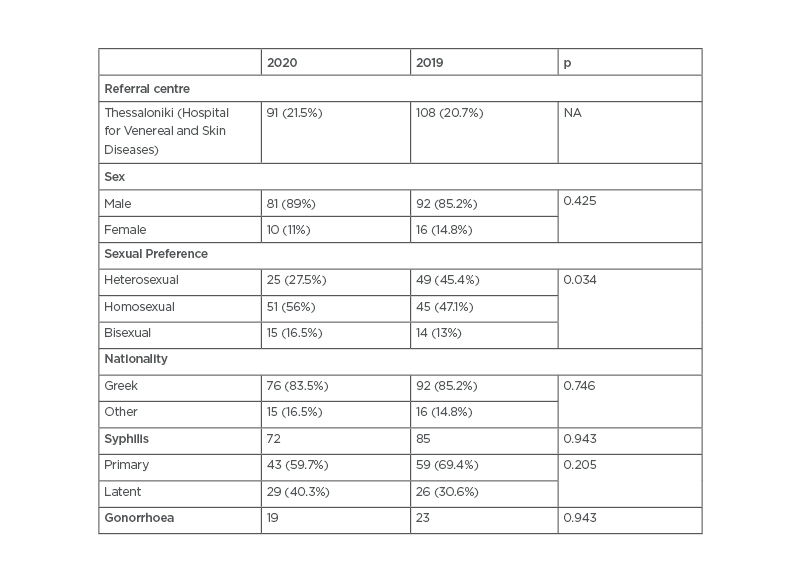BACKGROUND
During the COVID-19 outbreak, many countries imposed restrictive measures that resulted in unprecedented modifications in healthcare services.1 In several countries, including Greece, most of the public hospitals were practically transformed into COVID-19 units. In addition, public and health authorities repeatedly advised the population to avoid visiting hospitals during the pandemic outbreak. Moreover, social and sexual behaviour dramatically altered as a result of the strict social distancing measures.
Sexually transmitted diseases (STDs), though generally deemed as a major social health problem, rarely end up as an urgent life-threatening condition.2 Therefore, it is not surprising that the findings of studies from several countries reported a reduced number of STDs diagnosed in 2020 as compared with previous years.3
MATERIALS AND METHODS
The authors reviewed records of the STDs clinic of the State Hospital of Skin and Venereal Diseases, Thessaloniki, Greece, to identify newly diagnosed cases of gonorrhoea and syphilis from 1st March–30th October, 2020 and compared it with the respective numbers of the same period in 2019.
RESULTS
The total number of new diagnoses of syphilis and gonorrhoea in 2020 was 91, whereas in 2019 it was 108. The number of newly diagnosed cases of syphilis in 2020 was 72, slightly lower than the 85 cases of 2019 (p=0.943). Similarly, 19 patients were diagnosed in 2020 with gonorrhoea, fewer than the 23 diagnosed in 2019 (p=0.943). Regarding sexual preference, the percentage of heterosexual individuals was significantly lower in 2020, while the percentage of homosexual individuals was higher. The ratio of native Greek patients to foreign patients was comparable in 2020 and 2019. Results are summarised in (Table 1).

Table 1: Results.
H-E: haematoxylin and eosin stain.
DISCUSSION
A reduction in newly diagnosed STDs was reported in several other countries during the COVID-19 outbreak. The most remarkable reduction was recorded in Madrid, Spain, where researchers reported a reduction of new syphilis and gonorrhoea cases in the first 26 weeks of 2020 by 73.2% and 81.4%, respectively, as compared with the same period of 2019.4 In Switzerland, syphilis diagnoses were reduced by 84.8% and gonorrhoea diagnoses reduced by 16.5% in 2020, as compared with 2019.5 In China, new syphilis diagnoses in 2020 were reduced by 8.2% as compared with 2019.6
A direct comparison of these percentages in the authors’ hospital is significantly limited by the heterogeneity of used data in terms of collection and reporting. In Greece, the authors’ hospital maintained, uninterruptedly, its function throughout the year and was never involved in hospitalising patients with COVID-19. Therefore, the impact of restricted access on the number of newly diagnosed STDs should, reasonably, be less evident. Despite of the different magnitude of the reported trends, data from all countries converge to the conclusion that considerably fewer STDs were diagnosed in 2020 as compared with 2019.
The reduced number of newly diagnosed STDs could be attributed to various reasons. Limited access or unwillingness of patients to visit a hospital in the fear of COVID-19 transmission is a potential explanation. Social distancing and fear of physical contact that might enhance transmission as well as banned entertainment activities that facilitate casual sex further contribute to the reduction in STDs.
Considering potential long-term consequences of undiagnosed STDs and the significant impact they might have on social health, the authors results, along with those from other countries, highlight the need of uninterrupted testing and treatment of STDs during a pandemic course.







